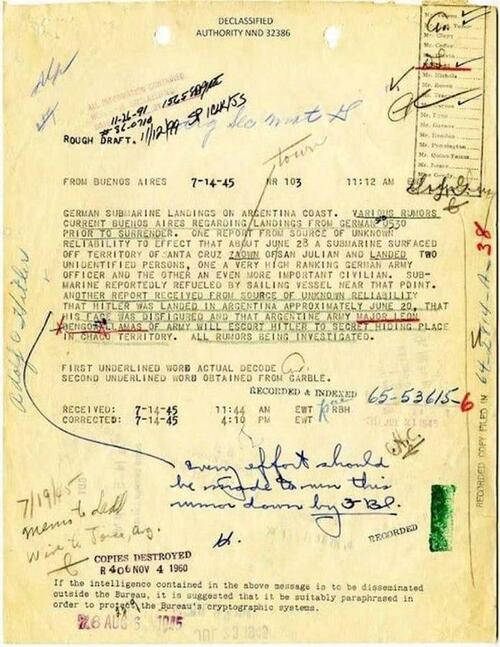
Аргентина рассекретила нацистские архивы Но разве Гитлер тоже туда сбежал?
Автор: Джон Флитвуд,
Президент Аргентины Хавьер Милей распорядился полностью рассекретить секретные правительственные файлы, связанные с нацистами, которые бежали в Аргентину после Второй мировой войны, наряду с архивами собственной военной диктатуры страны.
Обещание раскрытия информации следует за более широкой глобальной тенденцией к прозрачности, включая недавнюю публикацию правительством США давно засекреченных файлов, связанных с убийством президента Джона Ф. Кеннеди — документов, которые на протяжении десятилетий скрывались от общественности по заявлениям национальной безопасности.
Я раскрываю действия Аргентины по рассекречиванию нацистских файлов, а документы ФБР утверждают, что Гитлер пережил Вторую мировую войну и сбежал в Аргентину.
Гитлер был высажен в Аргентине примерно 20 июня 1945 года. Его лицо было обезображено. "
Полная история в видео:
#Гитлер #Аргентина... pic.twitter.com/Q6eq2z8Yz3
— Jon Fleetwood (@JonMFleetwood) 31 марта 2025 г.
Но с сообщениями о том, что 5000 нацистов сбежали в Южную Америку, включая высокопоставленных осужденных военных преступников, таких как Адольф Эйхман и Йозеф Менгеле, некоторые задаются более взрывоопасным вопросом: пережил ли Гитлер войну и сбежал ли в Аргентину?
Глава кабинета министров Гильермо Франко подтвердил, что приказ Милея, сделанный после встречи с сенатором США Стивом Дейнсом, распространяется на все связанные с нацизмом документы в государственных учреждениях, включая файлы Министерства обороны и финансовые записи, давно окутанные тайной.
Президент Милей распорядился опубликовать и рассекретить архивы. Франко сказал. Эти документы касаются нацистов, которые искали убежища в Аргентине и были защищены в течение многих лет. Это исторические документы, которые должны быть доступны для общественности. "
«Нет причин продолжать защищать эту информацию», — добавил он. «Это архивы части аргентинской истории, и они должны быть общедоступными. "
Этот шаг также возрождает давнее утверждение, отвергнутое основными историками, но не всеми, что Адольф Гитлер не умер в Берлине в 1945 году, а вместо этого бежал через Испанию и в конечном итоге жил под защитой в Южной Америке.
Маршрут побега, о котором никто не должен был говорить
Историки задокументировали побег высокопоставленных нацистов в Аргентину — Эйхман был захвачен израильскими агентами Моссада в Буэнос-Айресе в 1960 году; Менгеле умер десятилетия спустя под фальшивой личностью в Бразилии.
Так почему же сеть, защищавшая их, не защитила и Гитлера?
На этот вопрос аргентинский журналист и писатель Абель Басти потратил свою карьеру, пытаясь ответить.
В книгах как Гитлер в изгнании и Гитлер в АргентинеБасти утверждает, что Гитлер сбежал через туннель под Берлином в аэропорт Темпельхоф, бежал в Испанию, а затем отправился на подводной лодке в Аргентину, где жил при поддержке СС и помощи сочувствующих немецких иммигрантов.
Он цитирует рассекреченные отчеты ФБР, предполагаемые наблюдения в Патагонии и фотографии, которые, по его словам, показывают Гитлера с известными нацистскими сторонниками в Аргентине.
Отель «Эден» в Ла-Фальде, являющийся горячей точкой для нацистской деятельности в середине 20-го века, находится в центре многих из этих претензий.
Басти считает, что Гитлер остался там с Уолтером и Идой Эйхорн, известными нацистскими лоялистами, которые управляли собственностью.
Документы разведки США того времени содержат десятки непроверенных сведений о наблюдениях Гитлера в Южной Америке.
Теперь порядок рассекречивания Милея может позволить исследователям и скептикам прочесывать эти файлы из первых рук.
Документ ФБР раскрывает слухи о побеге после смерти Гитлера
В рамках серии блогов Национального архива под названием «Охота на Гитлера» два отчета ФБР, опубликованные в 2015 году, пересматривают таинственные слухи 1945 года, предполагающие, что Гитлер сбежал в Аргентину.
В одном из сообщений, отправленных из Буэнос-Айреса 14 июля 1945 года, утверждалось, что «источник неизвестной надежности» сказал: «Гитлер был приземлен в Аргентине примерно 20 июня, что его лицо было обезображено». и что майор аргентинской армии готовился сопровождать его в «секретное укрытие на территории Чако». "
В докладе добавлено: «Все слухи расследуются. "

Во втором документе, датированном 14 августа ФБР в Лос-Анджелесе, рассказывается о заявлении голливудского актера, который сказал, что человек в клубе сказал ему, что у него «огромная проблема, которая его беспокоит». "
Этот человек якобы сказал, что он был одним из четырех человек, которые встретились с Гитлером и его партией, когда они приземлились с подводных лодок в Аргентине через две с половиной недели после падения Берлина. "
Оба документа появляются в книге «Охота на Гитлера, часть VII: поиски продолжаются с июня по сентябрь 1945 года», автором которой является историк Национального архива Грег Брэдшер.
Аргентина была не единственной страной, где жили нацисты
Стоит отметить, что Аргентина была не одинока в предоставлении убежища нацистским чиновникам.
Правительство Соединенных Штатов через секретную программу, известную как операция «Скрепка», после войны ввезло в страну более 1600 немецких ученых, инженеров и техников.
Многие из этих людей имели прямые связи с нацистским режимом, а некоторые были связаны с военными преступлениями.
Одним из самых известных новобранцев Paperclip был Вернер фон Браун, бывший офицер СС и архитектор нацистской ракетной программы V-2, который позже стал ведущей фигурой в программе НАСА «Аполлон».
Разведка США почистила их записи и дала им новую жизнь в американских институтах исследований, военных разработок и освоения космоса.
Если США были готовы игнорировать нацистские зверства во имя национальных интересов, возникает вопрос: сколько других стран сделали то же самое, и какая информация до сих пор не раскрыта?
Публичный трюк или исторический прорыв?
Критики утверждают, что это объявление не более чем политический театр.
Либертарианское правительство уже уволило многих архивистов и сотрудников, которые будут заниматься освобождением.
«Так кто же это сделает?» — спросили оппозиционные законодатели.
«Объявления — это чистая демагогия». Об этом сообщает местное издание.
На прошлой неделе Милей объявил о Национальном дне памяти, правды и справедливости в Аргентине, который ознаменовал начало военной диктатуры в стране в 1976-1983 годах.
Его администрация также пообещала рассекретить разведывательные файлы той эпохи, заявив, что «рассказ всей истории является важнейшей задачей. "
Тем не менее, самые важные откровения могут быть не о диктатуре Аргентины, а о том, что страна знала об одной из самых мрачных глав в мировой истории.
Ограничение, вымысел или классифицированный факт?
Основные историки, такие как Ричард Эванс, отвергают теорию бегства Гитлера как вымысел.
Они указывают на судебно-медицинские доказательства, такие как зубные останки Гитлера, которые соответствуют его известным записям и были подтверждены в 2018 году командой под руководством Франции, изучающей советские архивы.
Тем не менее вопросы остаются.
Почему американская разведка десятилетиями держала в секрете тысячи страниц нацистских наблюдений и расследований?
Почему Аргентина предложила убежище стольким осужденным военным преступникам?
И почему почти 80 лет спустя вся эта история остается в правительственных хранилищах?
Будет ли выпуск нацистских архивов Аргентины, наконец, положить конец теории побега или вдохнуть в нее новую жизнь, еще предстоит выяснить.
Но впервые за десятилетия файлы могут наконец увидеть дневной свет.
И если Милей выполнит свое обещание, мир может узнать, насколько глубока кроличья нора.
Тайлер Дерден
Свадьба, 04/02/2025 - 06:30













